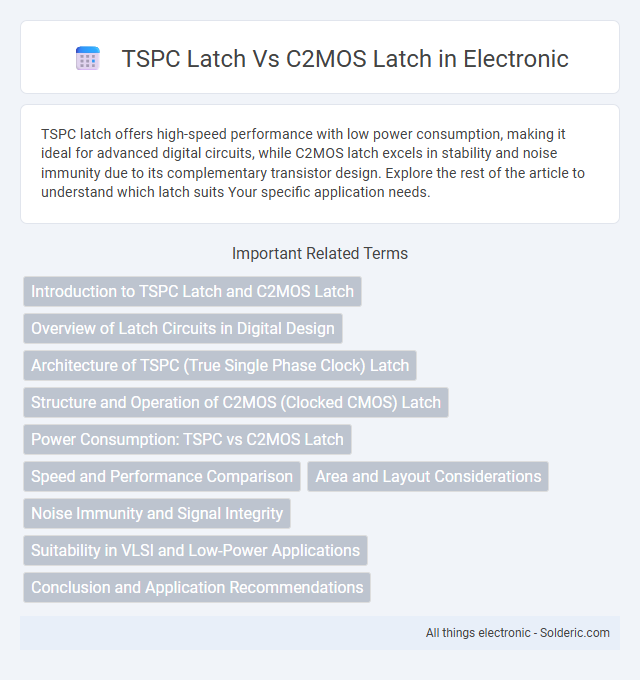TSPC latch offers high-speed performance with low power consumption, making it ideal for advanced digital circuits, while C2MOS latch excels in stability and noise immunity due to its complementary transistor design. Explore the rest of the article to understand which latch suits Your specific application needs.
Comparison Table
| Feature | TSPC Latch | C2MOS Latch |
|---|---|---|
| Full Form | True Single-Phase Clocked Latch | Complementary Cascade MOS Latch |
| Clock Phases | Single-phase clock | Two-phase clocks |
| Power Consumption | Lower dynamic power | Moderate power due to complementary stages |
| Speed / Performance | High speed, suitable for high-frequency circuits | Moderate speed |
| Complexity | Simpler design, fewer transistors | More complex, higher transistor count |
| Output Stability | Good noise margin | Strong drive with complementary output stages |
| Application | High-speed digital circuits, pipelining | Low to medium speed storage elements |
Introduction to TSPC Latch and C2MOS Latch
TSPC Latch (True Single-Phase Clock Latch) is a high-speed, low-power memory element commonly used in CMOS digital circuits for efficient data storage and synchronization. C2MOS Latch (Complementary CMOS Latch) utilizes complementary transistor pairs to achieve robust operation with reduced static power consumption and noise immunity. Understanding the fundamental differences in their clocking schemes and transistor configurations can help optimize Your circuit design for speed, power, and reliability.
Overview of Latch Circuits in Digital Design
TSPC latch circuits offer high-speed performance with low power consumption, making them suitable for high-frequency digital designs, while C2MOS latches provide robust noise immunity and better static power control due to their complementary transistor structure. Latch circuits function as fundamental memory elements that temporarily store binary information, playing a critical role in timing and synchronization within digital systems. Optimizing latch selection impacts overall circuit reliability, power efficiency, and operational speed in integrated circuit design.
Architecture of TSPC (True Single Phase Clock) Latch
The architecture of the TSPC (True Single Phase Clock) latch utilizes a single-phase clocking scheme with dynamic logic to achieve high-speed operation and low power consumption. It consists of a clever arrangement of pass transistors and cross-coupled inverters, where data is latched during a single clock phase, eliminating the requirement for complementary clock signals. This design reduces transistor count and clock skew issues compared to traditional C2MOS latches, improving overall circuit performance in advanced CMOS processes.
Structure and Operation of C2MOS (Clocked CMOS) Latch
The C2MOS latch features a complementary clocked structure with both PMOS and NMOS transistors arranged to control data storage using a clock signal, enabling low power consumption and reduced charge sharing. Its operation relies on the clock phases to alternate between transparency and hold modes, ensuring data is latched only during the active clock phase while isolating the stored value when the clock is inactive. The symmetric transistor arrangement in the C2MOS latch enhances noise immunity and minimizes glitches compared to conventional latches like TSPC, making it suitable for high-speed, low-power applications.
Power Consumption: TSPC vs C2MOS Latch
TSPC (True Single-Phase Clock) latches exhibit lower power consumption compared to C2MOS (Cascade CMOS) latches due to their reduced transistor count and single-phase clock operation, minimizing switching activity. The absence of complementary clock signals in TSPC design significantly decreases dynamic power dissipation, while C2MOS latches incur higher energy use from dual-phase clock driving and increased transistor switching. As a result, TSPC latches are preferred in low-power, high-speed applications where power efficiency is critical.
Speed and Performance Comparison
TSPC latches generally offer higher speed and better performance due to their dynamic operation and reduced transistor count, which minimizes delay and power consumption. In contrast, C2MOS latches, while more robust and stable under varying conditions, tend to have slower switching times because of their static CMOS topology. Your choice between TSPC and C2MOS latches should consider the trade-off between maximum speed and design stability for optimal circuit performance.
Area and Layout Considerations
TSPC latches typically offer smaller area footprints compared to C2MOS latches due to fewer transistors and simplified clocking schemes, making them suitable for high-density integrated circuits. The layout of TSPC latches benefits from reduced complexity, which can lead to shorter interconnect lengths and lower parasitic capacitances. In contrast, C2MOS latches require larger silicon area because of their complementary transistor pairs, and their layout complexity increases due to careful transistor matching and clock signal routing.
Noise Immunity and Signal Integrity
TSPC Latches exhibit superior noise immunity due to their dynamic operation and reduced transistor count, minimizing charge sharing and node disturbance under noisy conditions. C2MOS Latches offer enhanced signal integrity with complementary pull-up and pull-down networks that maintain a stable output voltage, reducing susceptibility to voltage fluctuations. The inherent design of TSPC latches allows faster transitions and lower glitch generation, while C2MOS latches provide robust output levels that resist signal degradation in mixed-signal environments.
Suitability in VLSI and Low-Power Applications
TSPC Latches offer superior speed and lower power consumption, making them highly suitable for low-power VLSI applications where minimizing energy and maximizing performance are critical. C2MOS Latches, while offering robustness and noise immunity, generally consume more power, limiting their efficiency in ultra-low-power VLSI designs. Your choice should prioritize TSPC Latches for advanced VLSI circuits focused on energy efficiency and high-speed operation.
Conclusion and Application Recommendations
TSPC Latches offer faster switching speeds and lower power consumption compared to C2MOS Latches, making them ideal for high-performance digital circuits such as microprocessors and high-frequency signal processing. C2MOS Latches provide better noise margins and robustness, suitable for applications requiring high reliability and low susceptibility to process variations, like low-power memory elements. Your choice should consider whether speed and power or stability and noise tolerance are the priority in your design.
TSPC Latch vs C2MOS Latch Infographic

 solderic.com
solderic.com